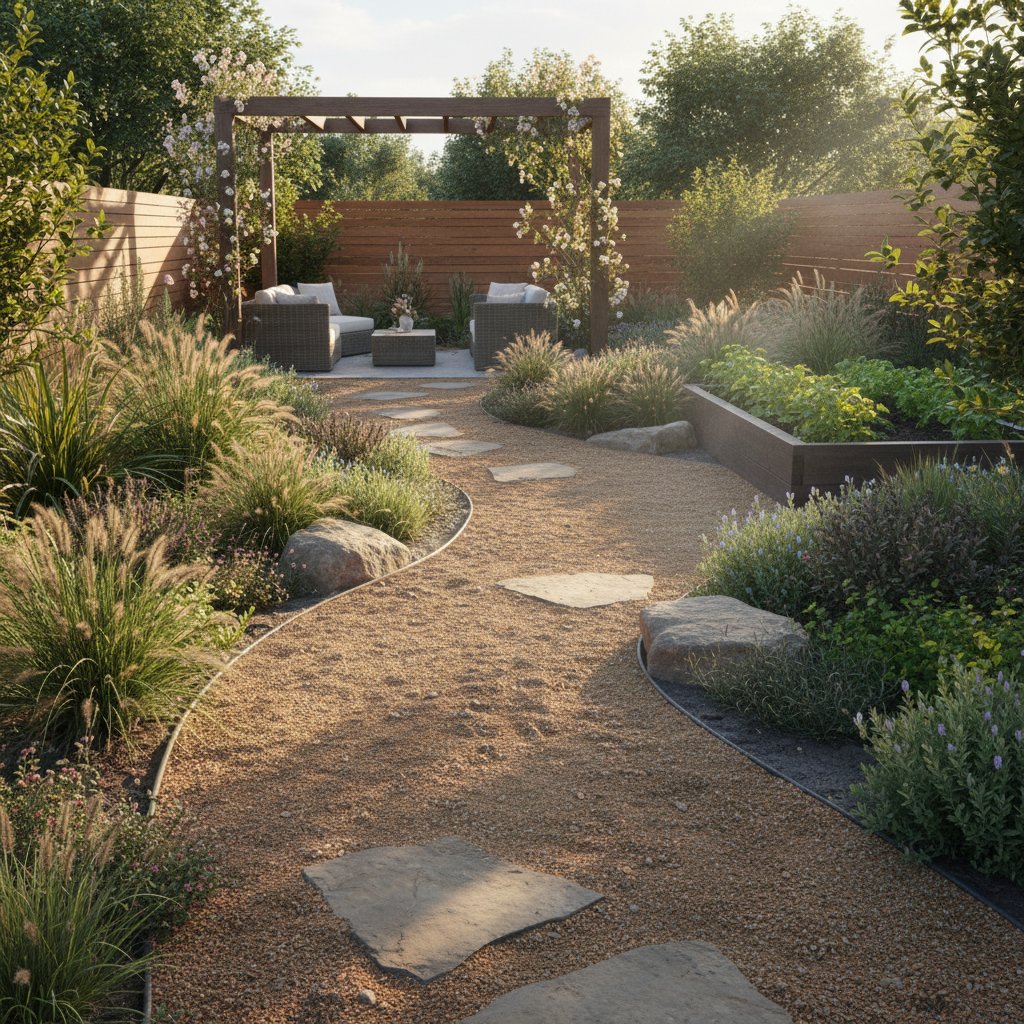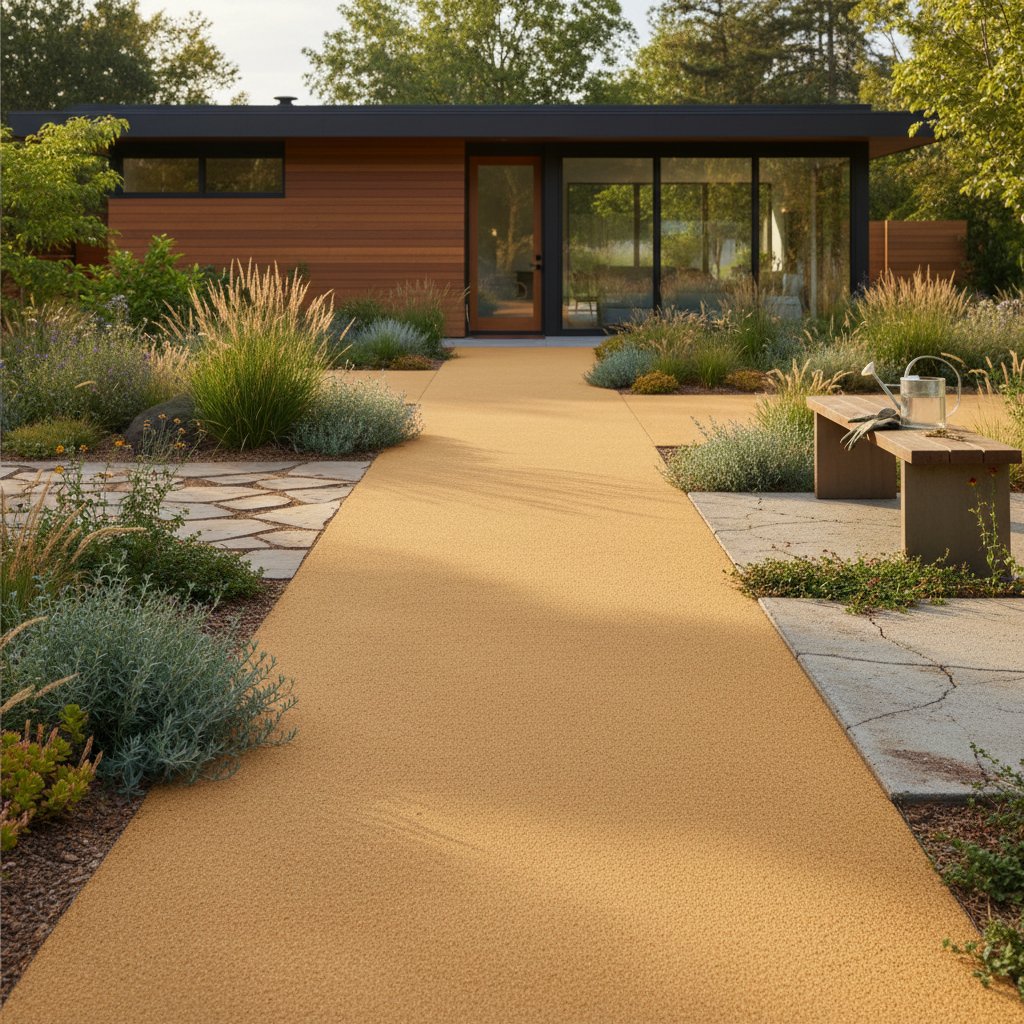The Rise of Decomposed Granite Patios in 2025
Homeowners seek patios that provide warmth and character beyond stark concrete or shifting pavers. Decomposed granite addresses this need by offering a natural surface that balances structure with softness. It grounds outdoor spaces visually and creates an emotional connection to the environment.
Understanding Decomposed Granite
Decomposed granite, known as DG, results from granite breaking down into fine gravel, silt, and clay over time. When compacted, it forms a stable yet permeable surface ideal for patios. This texture positions it between loose gravel and solid stone, providing an earthy feel.
Two primary types serve patio applications: loose DG and stabilized DG.
- Loose DG consists of the crushed material alone, suitable for casual paths where minor shifting occurs.
- Stabilized DG incorporates a binder for cohesion after compaction, ensuring smoothness for furniture and high-traffic areas.
The Appeal of Decomposed Granite
Decomposed granite excels through its understated elegance. Timeless hues ranging from warm golds and reds to neutral grays integrate with plants, wood elements, and stone features. It adapts to styles from rustic cottages to sleek modern designs.
Practical advantages enhance its allure. The surface remains cooler than concrete under sunlight, minimizes glare, and provides barefoot comfort. Sound absorption fosters a serene setting for outdoor gatherings or quiet relaxation.
Assessing Your Space
Evaluate your yard before selecting a patio material. Observe slopes, water accumulation patterns, and sunlight exposure throughout the day. Decomposed granite performs optimally on stable, well-draining soil; address pooling areas by grading or installing a gravel base layer.
Determine intended uses to guide your choice. Opt for stabilized DG with heavy furniture, fire features, or frequent traffic. Loose DG suits low-use zones like garden paths, evoking a relaxed, informal vibe.
Match DG colors to existing elements such as brick, stone, or stucco on your home. Select tones that harmonize to achieve a cohesive landscape appearance.
Planning the Layout
After assessing the site, design the patio shape to leverage decomposed granite's natural qualities. Organic curves and flowing edges enhance its innate appeal, echoing surrounding terrain.
Geometric designs work equally well when edged with steel or stone borders to contain the material. These boundaries prevent migration into adjacent areas while maintaining defined lines.
Incorporate smooth transitions to other surfaces like flagstone, concrete pavers, or wood decks. Combine materials to delineate functional zones, such as dining spots, lounging areas, or connecting walkways.
Preparing the Ground
Decomposed granite installation demands careful preparation for lasting results. Clear the area of weeds, grass, and debris, then excavate to four to six inches below the final surface level. Compact the native soil using a hand tamper or rented plate compactor for a solid foundation.
Install a two-inch layer of crushed gravel or road base to promote drainage and even settling. Compact this base firmly before proceeding.
Apply decomposed granite in two- to three-inch lifts, wetting each layer lightly to aid compaction. For stabilized DG, mix the binder per manufacturer guidelines and allow specified curing periods. The completed surface should feel firm with a subtle, natural texture.
Maintaining Your Patio
Decomposed granite patios demand minimal effort but respond well to routine care. Rake or sweep periodically to maintain levelness and remove debris. Extract emerging weeds promptly to prevent establishment.
Address settling after heavy rains by adding fresh DG, moistening, and recompacting low areas. Stabilized versions simplify upkeep; rinse with a hose and replenish as needed without harsh chemicals that could degrade the binder.
This material matures gracefully within the landscape. It develops patina from use, such as slight darkening or usage patterns, imparting a welcoming, authentic character absent in rigid concrete.
Environmental Benefits
Decomposed granite attracts environmentally conscious homeowners for its permeability. Rainwater infiltrates the surface rather than running off, mitigating erosion and replenishing soil moisture.
Sourced from natural granite with limited processing, it minimizes environmental impact, especially when obtained locally versus transported manufactured options.
Permeable design aids adjacent vegetation by directing water to garden beds or native plantings, promoting biodiversity and sustainable yard practices.
Style and Trends
Decomposed granite aligns with the shift toward integrated, nature-inspired outdoor spaces. It supports refined yet organic designs that prioritize landscape harmony over rigid structures.
Color options enable personalization: golden shades evoke Mediterranean warmth, while grays complement contemporary or forested aesthetics. Layering hues simulates natural stone formations for added dimension.
Landscape professionals value its adaptability. Use it to infill between stepping stones, border plantings, or extend from patios into pathways, creating unified, easy-care environments.
Cost and Longevity
Affordability bolsters decomposed granite's popularity. Installation expenses fall below those of pavers or flagstone, with occasional top-ups keeping long-term costs low.
Proper maintenance ensures durability matching the lifespan of the surrounding landscape. Stabilized DG withstands erosion and routine activity without fragmentation. Redesigning later proves straightforward, as removal or reuse requires minimal effort and expense.
Integrating Decomposed Granite into Daily Life
With your decomposed granite patio established, observe its evolution with seasonal light and weather. Rain enhances its depth, while bordering plants provide softening edges. This setup draws you outdoors for morning routines or evening social hours.
Sustain it through simple practices: clear debris post-storms, patch minor dips, and trim encroaching growth. Over years, the patio integrates as an extension of your home, fostering enduring outdoor enjoyment.
Decomposed granite embodies resilient, straightforward design. It links indoor comfort to natural surroundings, delivering reliable pleasure through changing seasons.



